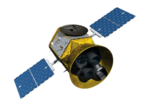Astronomy:Explorer 43
 Explorer 43 in space. | |||||||||||||||||||||||||||||
| Mission type | Space physics | ||||||||||||||||||||||||||||
|---|---|---|---|---|---|---|---|---|---|---|---|---|---|---|---|---|---|---|---|---|---|---|---|---|---|---|---|---|---|
| Operator | NASA | ||||||||||||||||||||||||||||
| COSPAR ID | 1971-019A[1] | ||||||||||||||||||||||||||||
| SATCAT no. | 5043[2] | ||||||||||||||||||||||||||||
| Mission duration | 3 1⁄2 years | ||||||||||||||||||||||||||||
| Spacecraft properties | |||||||||||||||||||||||||||||
| Manufacturer | GSFC | ||||||||||||||||||||||||||||
| Launch mass | 635 kg (1,400 lb) | ||||||||||||||||||||||||||||
| Start of mission | |||||||||||||||||||||||||||||
| Launch date | March 13, 1971, 16:15 UTC[3] | ||||||||||||||||||||||||||||
| Rocket | Delta M6 562/D83[3] | ||||||||||||||||||||||||||||
| Launch site | Cape Canaveral Air Force Station LC-17A[3] | ||||||||||||||||||||||||||||
| End of mission | |||||||||||||||||||||||||||||
| Decay date | October 2, 1974[2] | ||||||||||||||||||||||||||||
| Orbital parameters | |||||||||||||||||||||||||||||
| Reference system | Geocentric | ||||||||||||||||||||||||||||
| Regime | Highly Elliptical | ||||||||||||||||||||||||||||
| Eccentricity | 0.93678[1] | ||||||||||||||||||||||||||||
| Perigee altitude | 242 km (150 mi)[1] | ||||||||||||||||||||||||||||
| Apogee altitude | 196,574 km (122,145 mi)[1] | ||||||||||||||||||||||||||||
| Inclination | 28.7°[1] | ||||||||||||||||||||||||||||
| Period | 5,626.0 minutes[1] | ||||||||||||||||||||||||||||
| Epoch | March 13, 1971[1] | ||||||||||||||||||||||||||||
| Instruments | |||||||||||||||||||||||||||||
| |||||||||||||||||||||||||||||
Explorers | |||||||||||||||||||||||||||||
Explorer 43, also called as IMP-I and IMP 6, was a United States satellite launched as part of Explorers program. Explorer 43 as launched on March 13, 1971 on Cape Canaveral Air Force Station , with a Delta rocket. Explorer 43 was the sixth satellite of the Interplanetary Monitoring Platform.[4][1]
Spacecraft and mission
Explorer 43 continued the study, begun by earlier IMPs, of the interplanetary and outer magnetospheric regions by measuring energetic particles, plasma, and electric and magnetic fields. Its orbit took it to cislunar space during a period of decreasing solar activity.[5]
A radioastronomy experiment was also included in the spacecraft payload. The 16-sided spacecraft was 182.12 centimetres (71.70 in) high by 135.64 centimetres (53.40 in) in diameter. The spacecraft spin axis was normal to the ecliptic plane, and its spin rate was 5 rpm, with propulsion Star-17A. The initial apogee point lay near the earth-sun line. The solar-cell and chemical-battery powered spacecraft carried 2 transmitters. One continuously transmitted PCM encoder data at a 1,600 bps information bit rate.
The second transmitter was used for transmission of VLF data and for ranging information. Three orthogonal pairs of dipole antennas were used for the electric fields experiments, and one of these pairs was also used for the radioastronomy experiment. The members of the antenna pair along the spacecraft spin axis extended 2.9 m (9 ft 6 in), the members of the pair used in both the electric field and radio astronomy experiments extended 45.5 m (149 ft), and the members of the third pair were slightly unbalanced, extending 24.4 m × 27.6 m (80 ft × 91 ft), respectively. All four elements perpendicular to the spin axis were to have extended 45.5 m (149 ft).
The spacecraft reentered the earth's atmosphere October 2, 1974, after a highly successful mission.[1][4]
References
- ↑ 1.0 1.1 1.2 1.3 1.4 1.5 1.6 1.7 1.8 "IMP-I". NSSDC Master Catalog. NASA Goddard Space Flight Center. https://nssdc.gsfc.nasa.gov/nmc/spacecraft/display.action?id=1971-019A. Retrieved June 19, 2018.
 This article incorporates text from this source, which is in the public domain.
This article incorporates text from this source, which is in the public domain.
- ↑ 2.0 2.1 "EXPLORER 43 (IMP-6)". n2yo.com. 2011. http://www.n2yo.com/satellite/?s=5043. Retrieved June 19, 2018.
- ↑ 3.0 3.1 3.2 McDowell, Jonathan. "Launch Log". Jonathan's Space Page. http://www.planet4589.org/space/log/launchlog.txt. Retrieved June 19, 2018.
- ↑ 4.0 4.1 Wade, Mark (2011). "IMP". Encyclopedia Astronautica. http://www.astronautix.com/craft/imp.htm. Retrieved June 19, 2018.
- ↑ "Explorer Spacecraft Series". NASA. https://history.nasa.gov/explorer.html. Retrieved 30 March 2019.


